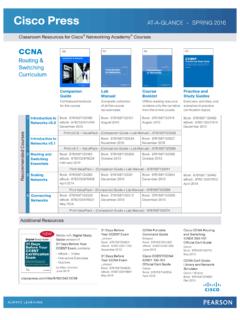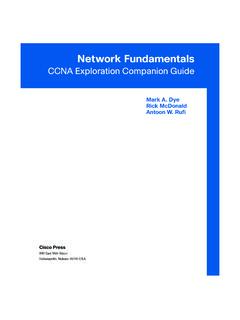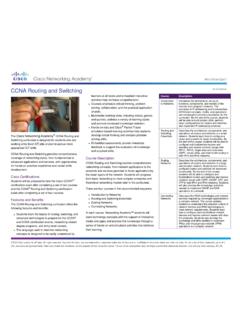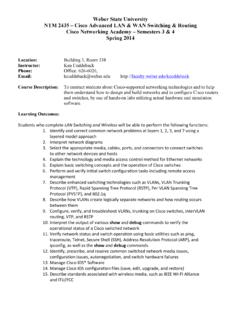Transcription of Scaling Networks Companion Guide - pearsoncmg.com
1 Scaling NetworksCompanion GuideCisco Networking AcademyCisco Press800 East 96th StreetIndianapolis, Indiana 46240 USAii Scaling Networks Companion GuideScaling Networks Companion GuideCisco Networking AcademyCopyright 2014 Cisco Systems, by: Cisco Press 800 East 96th Street Indianapolis, IN 46240 USAAll rights reserved. No part of this book may be reproduced or transmitted in any form or by any means, electronic or mechanical, including photocopying, recording, or by any information storage and retrieval system, without written permission from the pub-lisher, except for the inclusion of brief quotations in a in the United States of AmericaFirst Printing April 2014 Library of Congress Control Number: 2014932475 ISBN-13: 978-1-58713-328-2 ISBN-10: 1-58713-328-8 Warning and DisclaimerThis book is designed to provide information about the Cisco Networking Academy Scaling Networks course.
2 Every effort has been made to make this book as complete and as accurate as possible, but no warranty or fitness is information is provided on an as is basis. The authors, Cisco Press, and Cisco Systems, Inc. shall have neither liability nor responsibility to any person or entity with respect to any loss or damages arising from the information contained in this book or from the use of the discs or programs that may accompany opinions expressed in this book belong to the author and are not necessarily those of Cisco Systems, BogerAssociate PublisherDave DusthimerBusiness Operation Manager, Cisco PressJan CornelssenExecutive EditorMary Beth RayManaging EditorSandra SchroederDevelopment EditorEllie C. BruProject EditorMandie FrankCopy EditorJohn EdwardsTechnical EditorAubrey AdamsEditorial AssistantVanessa EvansDesignerMark ShirarCompositionBumpy DesignIndexerKen JohnsonProofreaderDebbie Williams iiiTrademark AcknowledgmentsAll terms mentioned in this book that are known to be trademarks or service marks have been appropriately capi-talized.
3 Cisco Press or Cisco Systems, Inc., cannot attest to the accuracy of this information. Use of a term in this book should not be regarded as affecting the validity of any trademark or service SalesFor information about buying this title in bulk quantities, or for special sales opportunities (which may include electronic versions; custom cover designs; and content particular to your business, training goals, marketing focus, or branding interests), please contact our corporate sales department at or (800) government sales inquiries, please contact For questions about sales outside the , please contact At Cisco Press, our goal is to create in-depth technical books of the highest quality and value. Each book is crafted with care and precision, undergoing rigorous development that involves the unique expertise of members from the professional technical feedback is a natural continuation of this process.
4 If you have any comments regarding how we could improve the quality of this book, or otherwise alter it to better suit your needs, you can contact us through email at Please make sure to include the book title and ISBN in your greatly appreciate your Scaling Networks Companion GuideAbout the Contributing AuthorAllan Johnson entered the academic world in 1999 after ten years as a business owner/operator to dedicate his efforts to his passion for teaching. He holds both an MBA and an in Occupational Training and Development. He is an information technology instructor at Del Mar College in Corpus Christi, Texas. In 2003, Allan began to commit much of his time and energy to the CCNA Instructional Support Team, providing services to Networking Academy instructors worldwide and creat-ing training materials.
5 He now works full-time for Cisco Networking Academy as a learning systems developer. vContents at a Glance Introduction xxChapter 1 Introduction to Scaling Networks 1 Chapter 2 LAN Redundancy 49 Chapter 3 LAN Aggregation 121 Chapter 4 Wireless LANs 145 Chapter 5 Adjust and Troubleshoot Single-Area OSPF 237 Chapter 6 Multiarea OSPF 315 Chapter 7 EIGRP 361 Chapter 8 EIGRP Advanced Configurations and Troubleshooting 453 Chapter 9 IOS Images and Licensing 517 Appendix A Answers to Check Your Understanding Questions 555 Glossary 569 Index 583vi Scaling Networks Companion GuideContents
6 Introduction xxChapter 1 Introduction to Scaling Networks 1 Objectives 1 Key Terms 1 Introduction ( ) 3 Implementing a network Design ( ) 3 Hierarchical network Design ( ) 3 The Need to Scale the network ( ) 3 Enterprise Business Devices ( ) 5 Hierarchical network Design ( ) 6 Cisco Enterprise Architecture ( ) 7 Failure Domains ( ) 9 Expanding the network ( ) 11 Design for Scalability ( ) 11 Planning for Redundancy ( ) 12 Increasing Bandwidth ( ) 13 Expanding the Access Layer ( ) 14 Fine-tuning Routing Protocols ( ) 15 Selecting network Devices ( ) 18 Switch Hardware ( ) 18 Switch Platforms ( ) 18 Port Density ( ) 21 Forwarding Rates ( ) 22 Power over Ethernet ( ) 23 Multilayer Switching ( ) 25 Router Hardware ( ) 26 Router Requirements ( ) 26 Cisco Routers ( ) 28 Router Hardware ( ) 29 Managing Devices ( ) 30 Managing IOS Files and Licensing ( ) 30In-Band Versus Out-of-Band Management ( ) 30 Basic Router CLI Commands ( ) 31 Basic Router show Commands ( ) 34 Basic Switch CLI Commands ( ) 39 Basic Switch show Commands ( ) 40 Summary ( ) 44 viiPractice 45 Class Activities 45 Labs 45 Packet Tracer Activities 45 Check Your Understanding Questions 46 Chapter 2 LAN Redundancy 49 Objectives 49 Key Terms 49 Introduction ( ) 51 Spanning Tree Concepts ( )
7 52 Purpose of Spanning Tree ( ) 52 Redundancy at OSI Layers 1 and 2 ( ) 52 Issues with Layer 1 Redundancy: MAC Database Instability ( ) 54 Issues with Layer 1 Redundancy: Broadcast Storms ( ) 56 Issues with Layer 1 Redundancy: Duplicate Unicast Frames ( ) 57 STP Operation ( ) 59 Spanning Tree Algorithm: Introduction ( ) 59 Spanning Tree Algorithm: Port Roles ( ) 61 Spanning Tree Algorithm: Root Bridge ( ) 63 Spanning Tree Algorithm: Path Cost ( ) BPDU Frame Format ( ) 67 BPDU Propagation and Process ( ) 68 Extended System ID ( ) 74 Varieties of Spanning Tree Protocols ( ) 77 Overview ( ) 77 List of Spanning Tree Protocols ( ) 78 Characteristics of the Spanning Tree Protocols ( ) 79 PVST+ ( ) 80 Overview of PVST+ ( ) 80 Port States and PVST+ Operation ( ) 82 Extended System ID and PVST+ Operation ( ) 83 Rapid PVST+ ( ) 84 Overview of Rapid PVST+ ( ) 84 RSTP BPDU ( ) 86 Edge Ports ( ) 87 Link Types ( ) 88viii Scaling Networks Companion GuideSpanning Tree Configuration ( ) 90 PVST+ Configuration ( ) 90 Catalyst 2960 Default Configuration ( )
8 90 Configuring and Verifying the Bridge ID ( ) 91 PortFast and BPDU Guard ( ) 93 PVST+ Load Balancing ( ) 95 Rapid PVST+ Configuration ( ) 98 Spanning Tree Mode ( ) 98 STP Configuration Issues ( ) 101 Analyzing the STP Topology ( ) 101 Expected Topology Versus Actual Topology ( ) 102 Overview of Spanning Tree Status ( ) 102 Spanning Tree Failure Consequences ( ) 103 Repairing a Spanning Tree Problem ( ) 105 First Hop Redundancy Protocols ( ) 105 Concept of First Hop Redundancy Protocols ( ) 106 Default Gateway Limitations ( ) 106 Router Redundancy ( ) 107 Steps for Router Failover ( ) 108 Varieties of First Hop Redundancy Protocols ( ) 109 First Hop Redundancy Protocols ( ) 109 FHRP Verification ( ) 110 HSRP Verification ( ) 110 GLBP Verification ( ) 112 Syntax Checker HSRP and GLBP ( ) 114 Summary ( ) 115 Practice 116 Class Activities 116 Labs 116 Packet Tracer Activities 116 Check Your Understanding Questions 117 Chapter 3 LAN Aggregation 121 Objectives 121 Key Terms 121 Introduction ( ) 122 Link Aggregation Concepts ( ) 122 Link Aggregation ( ) 123 Introduction to Link Aggregation ( ) 123 Advantages of EtherChannel ( ) 124 ixEtherChannel Operation ( ) 125 Implementation Restrictions ( ) 125 Port Aggregation Protocol ( ) 126 Link Aggregation Control Protocol ( )
9 128 Link Aggregation Configuration ( ) 130 Configuring EtherChannel ( ) 130 Configuration Guidelines ( ) 130 Configuring Interfaces ( ) 131 Verifying and Troubleshooting EtherChannel ( ) 133 Verifying EtherChannel ( ) 133 Troubleshooting EtherChannel ( ) 135 Summary ( ) 139 Practice 140 Class Activities 140 Labs 140 Packet Tracer Activities 140 Check Your Understanding Questions 141 Chapter 4 Wireless LANs 145 Objectives 145 Key Terms 145 Introduction ( ) 147 Wireless Concepts ( ) 147 Introduction to Wireless ( ) 147 Supporting Mobility ( ) 148 Benefits of Wireless ( ) 148 Wireless Technologies ( ) 149 Radio Frequencies ( ) Standards ( ) 151Wi-Fi Certification ( ) 153 Comparing WLANs to a LAN ( ) 154 Components of WLANs ( ) 156 Wireless NICs ( ) 156 Wireless Home Router ( ) 157 Business Wireless Solutions ( ) 159 Wireless Access Points ( ) 160 Small Wireless Deployment Solutions ( ) 162 Large Wireless Deployment Solutions ( , ) 165 Wireless Antennas ( ) 168x Scaling Networks Companion WLAN Topologies ( ) Wireless Topology Modes ( ) 170Ad Hoc Mode ( ) 170 Infrastructure Mode ( ) 171 Wireless LAN Operations ( ) Frame Structure ( ) 173 Wireless Frame ( ) 173 Frame Control Field ( ) 175 Wireless Frame Type ( ) 177 Management Frames ( ) 177 Control Frames ( )
10 180 Wireless Operation ( ) 181 Carrier Sense Multiple Access with Collision Avoidance ( ) 181 Wireless Clients and Access Point Association ( ) 183 Association Parameters ( ) 183 Discovering APs ( ) 187 Authentication ( ) 189 Channel Management ( ) 191 Frequency Channel Saturation ( ) 191 Selecting Channels ( ) 193 Planning a WLAN Deployment ( ) 196 Wireless LAN Security ( ) 198 WLAN Threats ( ) 198 Securing Wireless ( ) 198 DoS Attack ( ) 199 Management Frame DoS Attacks ( ) 200 Rogue Access Points ( ) 202 Man-in-the-Middle Attack ( ) 203 Securing WLANs ( ) 205 Wireless Security Overview ( ) 205 Shared Key Authentication Methods ( ) 206 Encryption Methods ( ) 208 Authenticating a Home User ( ) 208 Authentication in the Enterprise ( ) 210 Wireless LAN Configuration ( ) 211 Configure a Wireless Router ( ) 211 Configuring a Wireless Router ( ) 211 Setting U



















